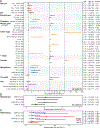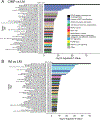DNA Methylation Classes of Stage II and III Primary Melanomas and Their Clinical and Prognostic Significance
- PMID: 39509669
- PMCID: PMC11737429
- DOI: 10.1200/PO-24-00375
DNA Methylation Classes of Stage II and III Primary Melanomas and Their Clinical and Prognostic Significance
Abstract
Purpose: Patients with stage II and III cutaneous primary melanoma vary considerably in their risk of melanoma-related death. We explore the ability of methylation profiling to distinguish primary melanoma methylation classes and their associations with clinicopathologic characteristics and survival.
Materials and methods: InterMEL is a retrospective case-control study that assembled primary cutaneous melanomas from American Joint Committee on Cancer (AJCC) 8th edition stage II and III patients diagnosed between 1998 and 2015 in the United States and Australia. Cases are patients who died of melanoma within 5 years from original diagnosis. Controls survived longer than 5 years without evidence of melanoma recurrence or relapse. Methylation classes, distinguished by consensus clustering of 850K methylation data, were evaluated for their clinicopathologic characteristics, 5-year survival status, and differentially methylated gene sets.
Results: Among 422 InterMEL melanomas, consensus clustering revealed three primary melanoma methylation classes (MethylClasses): a CpG island methylator phenotype (CIMP) class, an intermediate methylation (IM) class, and a low methylation (LM) class. CIMP and IM were associated with higher AJCC stage (both P = .002), Breslow thickness (CIMP P = .002; IM P = .006), and mitotic index (both P < .001) compared with LM, while IM had higher N stage than CIMP (P = .01) and LM (P = .007). CIMP and IM had a 2-fold higher likelihood of 5-year death from melanoma than LM (CIMP odds ratio [OR], 2.16 [95% CI, 1.18 to 3.96]; IM OR, 2.00 [95% CI, 1.12 to 3.58]) in a multivariable model adjusted for age, sex, log Breslow thickness, ulceration, mitotic index, and N stage. Despite more extensive CpG island hypermethylation in CIMP, CIMP and IM shared similar patterns of differential methylation and gene set enrichment compared with LM.
Conclusion: Melanoma MethylClasses may provide clinical value in predicting 5-year death from melanoma among patients with primary melanoma independent of other clinicopathologic factors.
Conflict of interest statement
AUTHORS’ DISCLOSURES OF POTENTIAL CONFLICTS OF INTEREST
RAS has received fees for professional services from SkylineDx BV, IO Biotech ApS, etaOptima Technology Inc., F. Hoffmann-La Roche Ltd, Evaxion, Provectus Biopharmaceuticals Australia, Qbiotics, Novartis, Merck Sharp & Dohme, NeraCare, AMGEN Inc., Bristol-Myers Squibb, Myriad Genetics, GlaxoSmithKline. PF has received research grants to current and former institutions from Ideaya, BMS, Pfizer and Taiho Oncology, as well as personal professional fees from BMS, Merck, GigaGen, Eisai, Novartis, Array, Hexal AG, Replimune, and Immunocore. BGR or spouse have stock ownership in Butterfly Networks, Inc, Quantum Si, Hyperfine Research, OrphAI Therapeutics, IdentifEye, Detect Labs, Protein Evolution, Inc, and spouse is on the board of directors of the above companies. The remaining authors state no conflict of interest.
Figures





References
-
- Gerami P, Cook RW, Wilkinson J, et al. : Development of a prognostic genetic signature to predict the metastatic risk associated with cutaneous melanoma. Clin Cancer Res 21:175–83, 2015 - PubMed
MeSH terms
Grants and funding
- P30 CA118100/CA/NCI NIH HHS/United States
- R01 CA233524/CA/NCI NIH HHS/United States
- R33 CA160138/CA/NCI NIH HHS/United States
- UL1 TR001863/TR/NCATS NIH HHS/United States
- P30 CA016086/CA/NCI NIH HHS/United States
- P50 CA225450/CA/NCI NIH HHS/United States
- R21 CA245577/CA/NCI NIH HHS/United States
- P30 CA008748/CA/NCI NIH HHS/United States
- P01 CA206980/CA/NCI NIH HHS/United States
- R03 CA199487/CA/NCI NIH HHS/United States
- K08 CA151645/CA/NCI NIH HHS/United States
- P50 CA221703/CA/NCI NIH HHS/United States
- R21 CA134368/CA/NCI NIH HHS/United States
- R01 CA121118/CA/NCI NIH HHS/United States
- P30 ES010126/ES/NIEHS NIH HHS/United States
- P30 CA016672/CA/NCI NIH HHS/United States
- T32 GM135128/GM/NIGMS NIH HHS/United States
LinkOut - more resources
Full Text Sources
Medical

